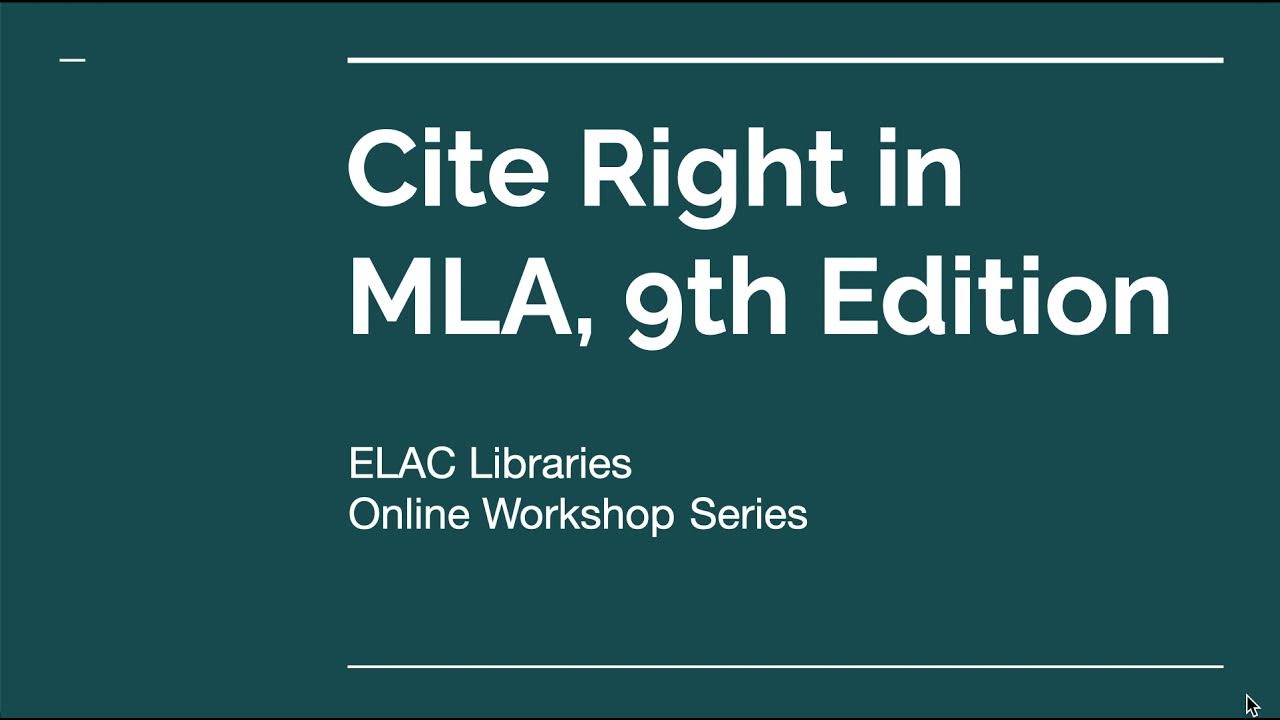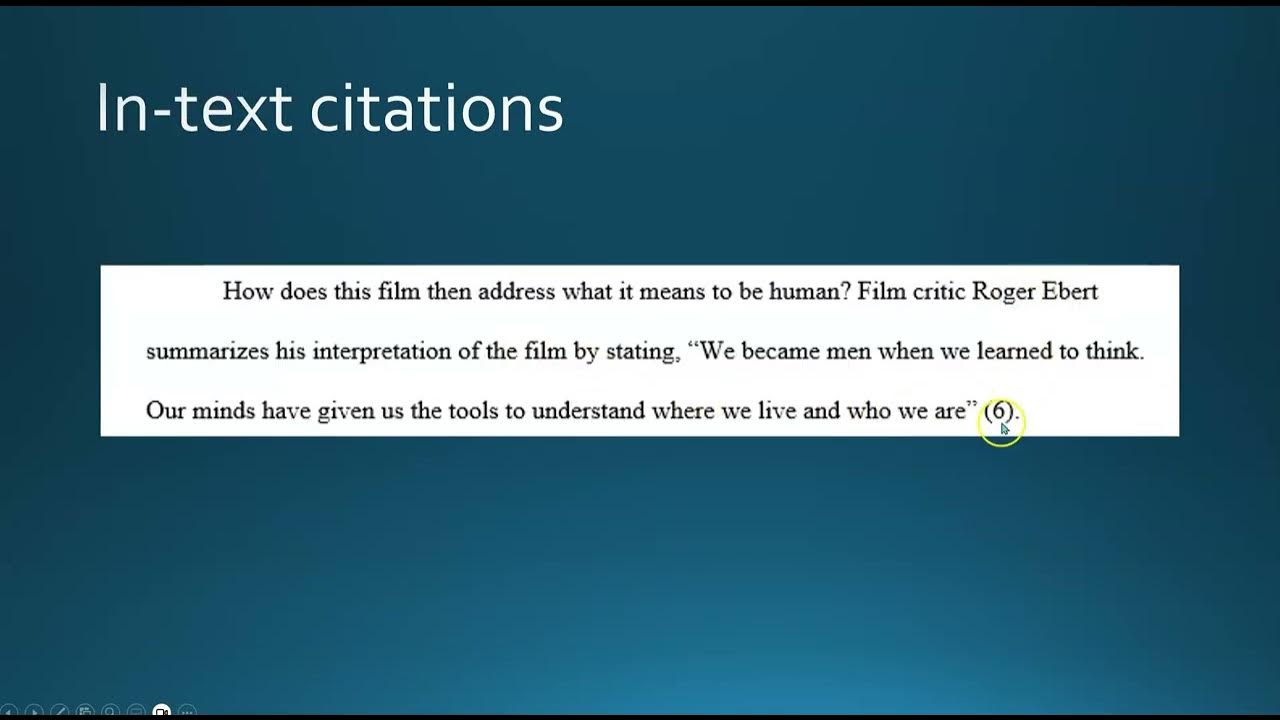Works Cited Page MLA 9th Edition: Creating References in MLA
Summary
TLDRIn this video, Chelsea walks viewers through the process of creating a Works Cited page using MLA 9th edition guidelines. She explains the nine essential elements that make up a citation, such as author, title of the source, contributor, publisher, and location. Through clear examples, Chelsea demonstrates how to format citations for various types of sources, including books, articles, and online content. The video emphasizes the importance of crediting creators properly and provides tips for handling different types of sources with varying details. It serves as a valuable guide for mastering MLA citation formatting.
Takeaways
- 😀 The MLA 9th edition works cited entries provide a structured way to credit sources in academic research.
- 😀 The first element of a citation is the author, listed with the last name first, followed by the first name.
- 😀 For two authors, the first author is listed in the usual format, followed by 'and' and the second author's name in normal order.
- 😀 For three or more authors, include only the first author followed by 'et al.' to represent the other authors.
- 😀 The title of the source (the work being cited) should be italicized, and the title of the container (if applicable) should also be italicized.
- 😀 If a work is part of a larger container (e.g., journal article in a journal), include the title of the container after the source title.
- 😀 Contributors such as editors, translators, or directors should be listed after the author with their role specified (e.g., 'edited by').
- 😀 The version element should specify the type of edition (e.g., 'expanded ed.') if applicable.
- 😀 The number element is used for sources that are part of a sequence, such as volumes or issues, and uses abbreviations like 'vol.' and 'no.' for numbering.
- 😀 The publisher is the entity responsible for producing the work and should be included unless omitted from the source.
- 😀 The publication date should be listed, focusing on the version of the work being cited. Include as much detail as available (e.g., year, month, day).
- 😀 The location element refers to where the source can be found, such as page numbers for print sources or URLs for online sources.
Q & A
Why is it necessary to have a Works Cited page in MLA format?
-A Works Cited page is essential for crediting authors whose materials you reference in your text, whether you paraphrase or quote them directly. It ensures proper academic attribution and follows research protocols agreed upon by the academic community.
What are the nine elements in an MLA Works Cited entry?
-The nine elements are: 1) Author, 2) Title of Source, 3) Title of Container, 4) Contributor, 5) Version, 6) Number, 7) Publisher, 8) Publication Date, 9) Location.
What is a 'container' in the context of MLA citation?
-A 'container' refers to a larger work that contains the source you're citing. For example, a book chapter is the source, while the book itself is the container. Not all sources will have a container, but if they do, it needs to be cited as part of the Works Cited entry.
How should an author's name be formatted in an MLA Works Cited entry?
-For one author, the name should be listed as 'Last Name, First Name.' For two authors, list the first author's name in the same format and the second author's name as 'First Name Last Name.' For three or more authors, list the first author followed by 'et al.'
What should you do if the source you're citing has three or more authors?
-If there are three or more authors, list the first author as 'Last Name, First Name,' followed by 'et al.' and a period. 'Et al.' is an abbreviation for 'and others.'
What is the difference between 'Title of Source' and 'Title of Container'?
-The 'Title of Source' refers to the work you're citing (e.g., a book, article, or episode), while the 'Title of Container' refers to the larger work that contains it, such as a journal, website, or series. Only include the 'Title of Container' if applicable.
How do you handle the formatting of titles in MLA citations?
-In MLA format, the 'Title of Source' should be italicized, while the 'Title of Container' should also be italicized. For example, a book title is italicized, but a chapter within that book would not be italicized.
When do you need to include the 'Contributor' element in an MLA citation?
-The 'Contributor' element should be included when someone other than the primary author played a significant role in creating the work, such as an editor, translator, or director. Include their role with appropriate labels, such as 'edited by' or 'translated by.'
What does the 'Version' element refer to in MLA citations?
-The 'Version' element is used when citing a specific edition or format of a work, such as an expanded edition, e-book, or revised version. This element is abbreviated as 'ed.' for edition.
How should you format the 'Publisher' element in MLA Works Cited?
-The 'Publisher' refers to the entity responsible for making the work available to the public. This could be a publishing company, a university press, or even a website. If no publisher is provided, simply omit this element from the citation.
What is meant by the 'Location' element in an MLA citation?
-The 'Location' element refers to where the source can be accessed. This might be a page range for a print source or a URL or DOI for an online source. For physical works, it could also refer to where the source is located, such as a library or archive.
What happens if some elements are missing from a source?
-In MLA formatting, not all sources will have every element. If an element is missing (e.g., no publisher or contributor), simply omit that element from the citation. MLA citations are flexible, and the goal is to include as much information as available.
Outlines

This section is available to paid users only. Please upgrade to access this part.
Upgrade NowMindmap

This section is available to paid users only. Please upgrade to access this part.
Upgrade NowKeywords

This section is available to paid users only. Please upgrade to access this part.
Upgrade NowHighlights

This section is available to paid users only. Please upgrade to access this part.
Upgrade NowTranscripts

This section is available to paid users only. Please upgrade to access this part.
Upgrade Now5.0 / 5 (0 votes)





